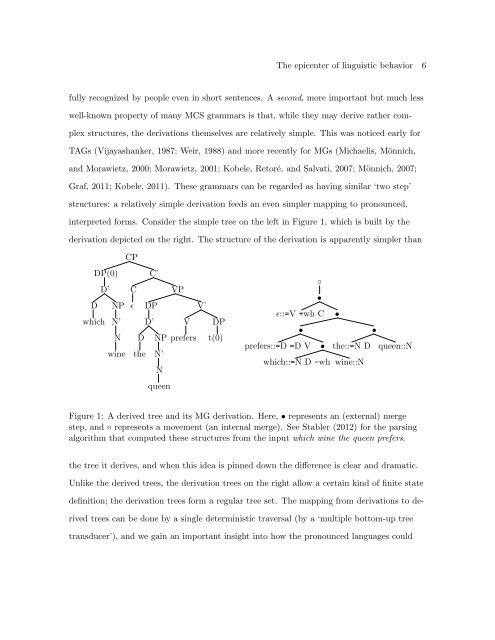The epicenter of linguistic behavior - UCLA Department of Linguistics
The epicenter of linguistic behavior - UCLA Department of Linguistics
The epicenter of linguistic behavior - UCLA Department of Linguistics
You also want an ePaper? Increase the reach of your titles
YUMPU automatically turns print PDFs into web optimized ePapers that Google loves.
<strong>The</strong> <strong>epicenter</strong> <strong>of</strong> <strong>linguistic</strong> <strong>behavior</strong> 6<br />
fully recognized by people even in short sentences. A second, more important but much less<br />
well-known property <strong>of</strong> many MCS grammars is that, while they may derive rather complex<br />
structures, the derivations themselves are relatively simple. This was noticed early for<br />
TAGs (Vijayashanker, 1987; Weir, 1988) and more recently for MGs (Michaelis, Mönnich,<br />
and Morawietz, 2000; Morawietz, 2001; Kobele, Retoré, and Salvati, 2007; Mönnich, 2007;<br />
Graf, 2011; Kobele, 2011). <strong>The</strong>se grammars can be regarded as having similar ‘two step’<br />
structures: a relatively simple derivation feeds an even simpler mapping to pronounced,<br />
interpreted forms. Consider the simple tree on the left in Figure 1, which is built by the<br />
derivation depicted on the right. <strong>The</strong> structure <strong>of</strong> the derivation is apparently simpler than<br />
CP<br />
DP(0)<br />
D’<br />
D NP<br />
which N’<br />
N<br />
wine<br />
C’<br />
C VP<br />
ǫ DP V’<br />
D’ V DP<br />
D NP prefers t(0)<br />
the N’<br />
N<br />
queen<br />
◦<br />
•<br />
ǫ::=V +wh C •<br />
•<br />
prefers::=D =D V •<br />
which::=N D -wh wine::N<br />
•<br />
the::=N D queen::N<br />
Figure 1: A derived tree and its MG derivation. Here, • represents an (external) merge<br />
step, and ◦ represents a movement (an internal merge). See Stabler (2012) for the parsing<br />
algorithm that computed these structures from the input which wine the queen prefers.<br />
the tree it derives, and when this idea is pinned down the difference is clear and dramatic.<br />
Unlike the derived trees, the derivation trees on the right allow a certain kind <strong>of</strong> finite state<br />
definition; the derivation trees form a regular tree set. <strong>The</strong> mapping from derivations to derived<br />
trees can be done by a single deterministic traversal (by a ‘multiple bottom-up tree<br />
transducer’), and we gain an important insight into how the pronounced languages could
















